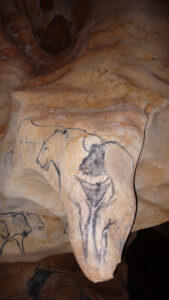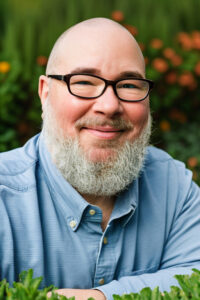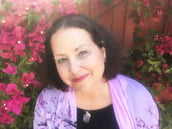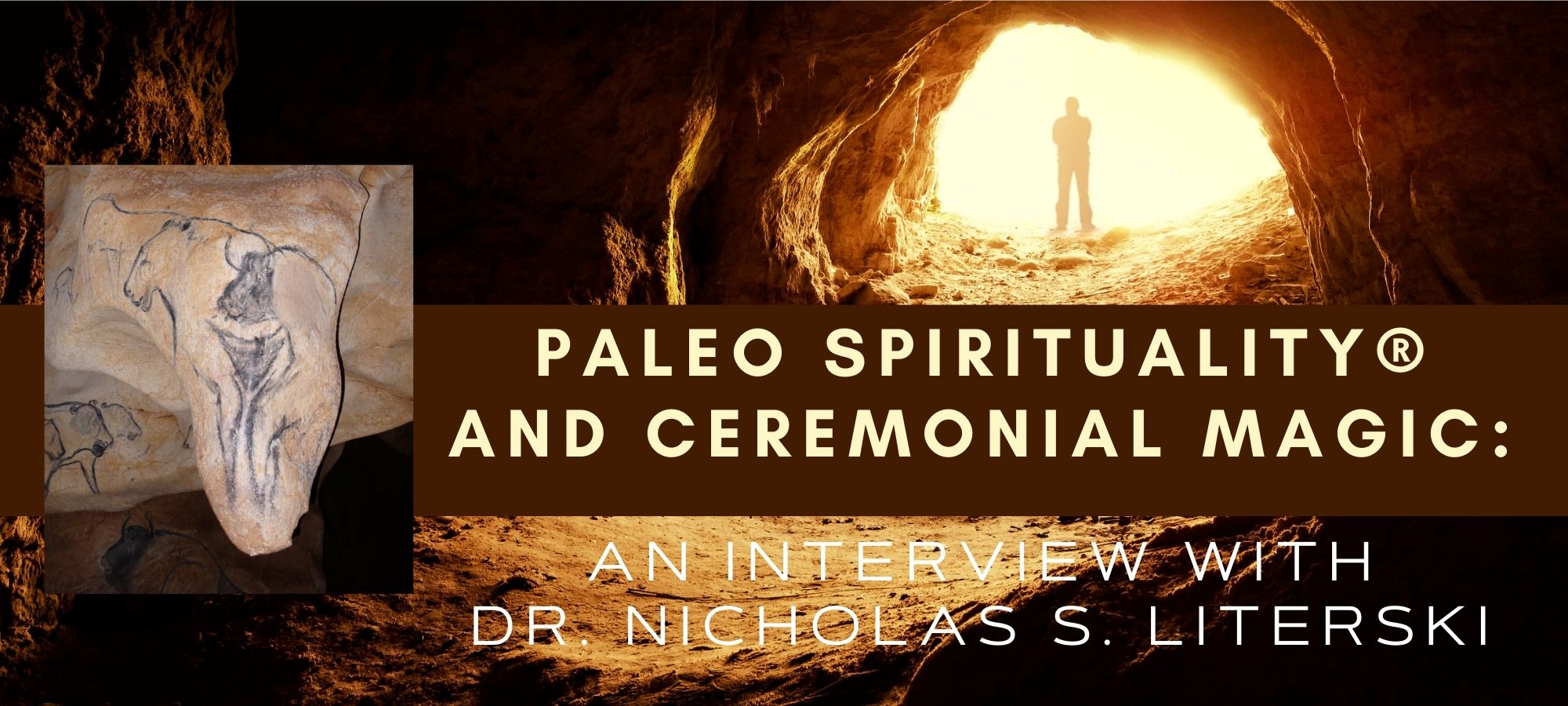Nicholas S. Literski is a lecturer in psychology, a professional spiritual guide, and an alumni of Pacifica’s Depth Psychology with Emphasis in Jungian and Archetypal Studies program. I’m delighted to hear more about their work and perspective.
Angela Borda: I’m very curious about Paleo Spirituality®, which you created as “an intentional process using symbols and images to engage your personal spirituality in ways that align with, and take advantage of, thousands of years of human evolution.” How did you conceive of the idea and how did it evolve?

Nicholas S. Literski: This was originally conceived as part of my dissertation at Pacifica, which was a depth psychological analysis of 36,000 year old cave art images in Chauvet Cave, with an eye toward what they could tell us about the human religious instinct. Chauvet Cave is clearly a ritual setting, and the images were part of that ritual. I wanted to gain insight into what drives our spiritual needs, getting as early as possible before our modern traditions and trappings. Paleo Spirituality stems from that work, treating images as distinct others that we can work with using active imagination to re-enchant our world. There are animistic elements to this, but ultimately it is about finding the divine in our world, and discovering more useful ways to approach the divine. Some will remember the “paleo diet” of several years ago, where persons were supposed to eat in a way that the human body has evolved to handle food. Paleo Spirituality® is a somewhat similar approach, engaging the numinous in a way that our psyche has evolved.
The most basic example of Paleolithic cave art, found in every culture and location on the planet, is the human hand, either printed or stenciled on rock surfaces. In some ways that is a message of “I was here.” Some researchers, however, believe that our ancestors saw the cave wall as a boundary between this reality and another imaginal or spiritual reality. So the fact that the hand print is ubiquitous through all early human imagery shows us that deep-set need we have to make contact with the numinous.
Angela: I imagine that if it were a time when building a church or a sacred building wasn’t an option, that going down into the earth through a cave would be a holy experience. What is your take on that?
Nick: Paleolithic cave art almost always appears deep within the caves, often through difficult passages. In Chauvet Cave, the most important image has been called the “Venus and Sorcerer” panel is the culmination of the ritual journey through difficult terrain. There is a revelation to be had through that journey, which is spiritual but also physical. We have many representations throughout ancient cultures of the underground as a womb or the mother goddess. So going back into the womb, they would receive this revelation and come out reborn.
There’s some suggestion that our great cathedrals were modeled from these caves, and as you go into massive cathedrals, they are essentially man-made caverns. The caves remained a sacred place, very prominent in Mayan culture and ancient Greece. We tend to overestimate the survival needs of Paleolithic peoples. If you look at the fossil record and climate from this time period, they had much more leisure time than we do now. They didn’t work a 9-to-5 job; they hunted when they needed food. They didn’t live in the painted caves. In almost every case, they were treated as sacred spaces, often forbidden spaces outside of the ritual context. Entering the underworld was simply too dangerous, unless you were going there for this specific ritual journey.
Angela: So in working with your clients, do you take them on a similar journey?
Nick: I teach my clients and students how to engage with images, using tools such as active imagination. We start with early human expressions but also work with images in nature, art, and cinema. Ultimately I have my students and clients create their own images, which they then engage those images as autonomous others with insight to offer. We treat the image itself as an autonomous other. It exists in and of itself, as a living being. We don’t know who made “the Venus and Sorcerer” panel, for example, but we treat that image as alive.
Angela: Have you been to see anything like the caves in France? What was the experience like? Is there an impact to viewing that art in person that connects you to our ancestors?
Nick: Many of the caves are closed to the public in order to preserve the art. Mistakes were made with Lascaux cave, where the breath of thousands of tourists created mold on the walls. The decorated caves we find now are usually closed off. In France, the government has created full-scale replicants. They created one of these about a mile away from Chauvet Cave, reproduced down to the millimeter. Even the scent and temperature are recreated, so you can experience the images. Visiting those is a numinous experience in and of itself. It’s a connection with our ancestors. When Chauvet Cave was first discovered, the discoverers had a sense that they were being watched, as if they’d come into this area and interrupted the original artists. That 36,000-year gap collapses into immediate presence and we are confronted with the fact that we are one with these ancestors. The images become just as numinous for us as they ever were for those who made them or saw them thousands of years ago.
Angela: What do you find to be special and unique about Pacifica?
Nick: Pacifica is a container that is really well-crafted to help individual students achieve their own dreams and destinies. There is so much space at Pacifica for students to craft their own experience in an atmosphere where the faculty support them. One thing I appreciate is the humility among the faculty. There is a sense of co-learning there. Just as the students are on a journey, so are the faculty, who are also working on their own discoveries. There is a community there that is so nurturing. You feel it when you come to campus.
Angela: I agree completely! And how did your degree from Pacifica impact your professional trajectory?
Nick: My degree at Pacifica has richly added to my work as a professional spiritual guide. I work with my clients from a predominantly Jungian perspective that informs the ideas and tools I bring to them. In addition, Pacifica placed me in a position to become an adjunct lecturer. It prepared me for going into that area of academia, which I have found really enriching. I love teaching and working with my students.
Angela: Is there something in particular about the M.A./Ph.D. in Depth Psychology with Specialization in Jungian Psychology and Archetypal Studies program (DJA) that you can share with us, perhaps with people who are trying to decide which program is right for them?
Nick: One thing I really appreciate is that Pacifica prepared us so well as writers and presenters. When we go into the larger Jungian world, we find that those who attended Pacifica have an advantage, because the program required us to develop strong skills in writing and presenting our ideas. We come out of DJA well prepared to enter the scholarly conversation and make an impact on moving Jung’s work forward.
You can read Part II of this interview here. To learn more about our DJA program, click here.

Nicholas S. Literski, JD, PhD, is an Adjunct Senior Lecturer in Psychology and Senior Program Manager in the School of Undergraduate Studies at the California Institute of Integral Studies, and a professional spiritual guide. Nick holds a PhD in Depth Psychology with Emphasis in Jungian and Archetypal Studies from Pacifica Graduate Institute, and a Master’s Degree in Spiritual Guidance from Sofia University. Their research interests include depth psychological reflections on spirituality, Paleolithic cave art, ceremonial magic, sexual orientation, and gender identity. Nick’s work has been published in Psychological Perspectives; Immanence: The Journal of Applied Mythology, Legend, and Folklore; Somatics Magazine-Journal of the Mind-Body Arts and Sciences; and the recent compilation, The Reality of Fragmentation and the Yearning for Healing: Jungian Perspectives on Democracy, Power, and Illusion in Contemporary Politics. Their new book, Method Infinite: Freemasonry and the Mormon Restoration, was released in August 2022.

Angela Borda is a writer for Pacifica Graduate Institute, as well as the editor of the Santa Barbara Literary Journal. Her work has been published in Food & Home, Peregrine, Hurricanes & Swan Songs, Delirium Corridor, Still Arts Quarterly, Danse Macabre, and is forthcoming in The Tertiary Lodger and Running Wild Anthology of Stories, Vol. 5.


